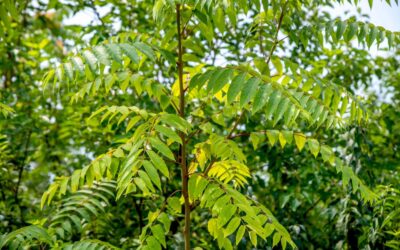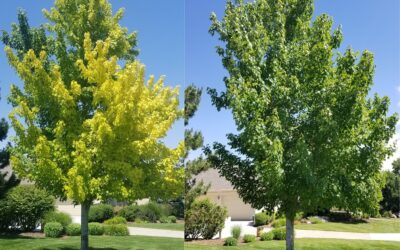Despite originating in China thousands of years ago, many people consider the apple the all-American fruit. And while the U.S. is the world’s second-largest producer of apples, its 5-million-ton annual harvest pales in comparison to China’s 41 million.
Nonetheless, the apple, in its more than 7,500 different cultivars, thrives worldwide in all but the most extreme climates—including Colorado. Because most apple trees need at least 600 hours below 40° F to encourage their fruit to set, followed by 5-6 hours of full sun per day after blossoming, our climate suits them fine. They’re hardy to Zone 4 and many varieties do well at altitudes up to 8,000 feet, making them one of the few fruit trees that are suitable for Colorado’s higher country. Add the fact that most apples are late bloomers, protecting them against the late spring frosts that can wreak havoc with other fruiting trees, and you can see why apple trees do so well here.
More than any other fruit, the apple has woven its way into Western folklore, from Greek and Roman mythology to Northern European cultures and America’s own Johnny Appleseed. And then there’s the Garden of Eden, where the forbidden fruit has been depicted as an apple from the earliest days of Christian iconography in what many scholars believe was a case of mistaken identity. The Latin word for apple, malus, is spelled the same as evil, but is pronounced differently (a long A vs a short A) and looks the same when written. Besides, apples didn’t come into the Middle East until long after the presumed time of Genesis. Nevertheless, the apple has become a symbol for knowledge, temptation and mortality. And its versatility as both a raw and cooked fruit make it a staple in kitchens worldwide.
Size, Varieties and Fruit
Apple trees are deciduous, standing from six feet tall in dwarf cultivars to nearly 40 feet in the wild. The size, shape, and density are dependent on the type of cultivar and how they are pruned. Dwarf and semi-dwarf varieties are favored for landscape planting because they’re easier to prune, their fruit is more accessible, and they take up less space. This becomes important because most apple trees need another nearby tree to pollinate, preferably of another variety for most successful results. As long as the other tree is within about 200 feet, bees will be able to carry pollen between them, so your neighbor’s tree will do just fine.
Dwarf apple trees grow to between 6 and 15 feet; semi-dwarfs from 12 to 20 feet; and standard up to 30 feet tall, but the fruit remains roughly the same size. Dwarf trees tend to produce fruit within 3-5 years of planting, while larger trees take longer.
Colorado Apple Tree Varieties
A wide variety of apples grow well in Colorado, but some have been bred for other climates. Choose from over a dozen varieties like Red and Golden Delicious, Gala, Granny Smith and Jonathan that mature before early October to avoid losing fruit to an early freeze.
Foliage and Flowers
Aside from their delicious fruit, apple trees add beauty to a landscape. The leaves are dark green ovals with serrated edges and a downy underside. Showy white five-petal flowers with an initial pink tinge are produced on spurs and shoots, and are about 1½ inches wide. They emerge in spring along with the leaf buds. The fruit matures in late summer or early autumn, developing a variety of skin colors from deep red to bright yellow.
Drought-Tolerant and Low Maintenance
Apple trees are relatively drought-tolerant and require much less water than a lawn. Overwatering causes them to grow faster and be more succulent, making them more susceptible to pests and disease. If possible, plant them in full sun at least a foot away from grassy areas, only water them for an hour or so every two weeks, and mulch around them to preserve moisture and keep competing vegetation away. They usually only need fertilizer in nitrogen-poor soils.
Pruning for Fruit Production
Proper pruning encourages fruit production. Keep the tree wide with plenty of room for air circulation and sunlight and avoid crowding the growing fruit. Pruning should be done after leaf drop in the fall or even better in early March before the buds emerge, but prune with a light touch on freshly planted trees. They need as much foliage as possible to establish themselves. Remove only dead or injured branches on new trees and limit mature pruning to one-third for best yield. Once the fruit begins to form, thin it for better development and to prevent overweight branches from breaking.
Preventing Fire Blight, Apple Scab, Powdery Mildew and Coddling Moth Worms
Apple trees are disease- and pest-resistant, but fire blight can sometimes be a problem. Careful pruning can remove it and antibiotic sprays like streptomycin can kill the bacteria. Wet leaves encourage apple scab and powdery mildew, so good air circulation is important. There’s little you can do to avoid coddling moth worms, so to keep them out of your apples, spray the tree with pyrethrum weekly from blooming to harvest. A late March spray of dormant oil will kill mites, aphid, and scale.
Properly planted and maintained apple trees are some of the most beautiful, productive, and enjoyable fruit trees in Colorado. If you’re considering planting apple trees or other landscape trees and shrubs, or have ones that need maintenance, Donovan Arborists offers planting, pruning, and shearing services in the Denver area. We’re happy to give free estimates to homeowners and property managers for any services they may need.



